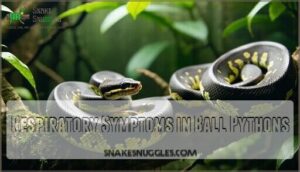This site is supported by our readers. We may earn a commission, at no cost to you, if you purchase through links.

By the time you notice lethargy or appetite loss, the underlying condition may have been developing for weeks. Recognizing subtle behavioral shifts, skin abnormalities, and respiratory changes early can mean the difference between straightforward treatment and life-threatening complications.
Understanding what normal looks like for your individual snake—its typical feeding response, activity patterns, and body condition—gives you the baseline to spot problems before they escalate into emergencies requiring intensive veterinary intervention.
Table Of Contents
Key Takeaways
- Ball pythons instinctively mask illness until disease has significantly progressed, making early detection of subtle behavioral shifts—like reduced activity, unresponsiveness, or appetite changes—critical for preventing life-threatening complications that require intensive veterinary intervention.
- Skin and shedding problems, particularly dysecdysis (incomplete shedding), retained eye caps, and mite infestations affecting up to 72.7% of some collections, signal underlying husbandry failures or systemic illness that can rapidly escalate to secondary infections without prompt professional treatment.
- Respiratory symptoms including open-mouth breathing, audible wheezing, and nasal discharge indicate potentially fatal pneumonia or airway obstruction, with over 70% of severe cases showing open-mouth breathing and requiring immediate veterinary care to prevent septicemia.
- Preventive care through annual veterinary checkups, proper enclosure conditions (78-80°F cool side, 88-92°F basking area, 50-60% humidity), and vigilant daily monitoring improves disease recovery rates by up to 30% and catches subclinical infections before they become emergencies.
Common Behavioral Signs of a Sick Ball Python
Your ball python’s behavior often tells the story of its health long before physical symptoms appear. When something’s wrong, you’ll notice shifts in how your snake moves, eats, or interacts with its surroundings.
Here are the key behavioral warning signs that warrant your attention.
Lethargy and Reduced Activity
When your ball python spends most of its time curled up in one spot, barely moving even when you approach, it’s often the first quiet warning that something’s gone wrong. Healthy ball pythons display consistent activity levels—exploring their enclosure at night, investigating during feeding time, and responding to snake interaction.
Lethargy coupled with loss of appetite signals the need for immediate health monitoring and veterinarian consultation, as these behavioral cues often precede visible signs of illness before environmental factors can be ruled out.
Hiding or Unresponsiveness
While ball pythons naturally seek shelter, there’s a critical difference between normal hiding behavior and the defensive retreat of an animal too ill to respond to its surroundings. A sick snake won’t emerge for food, water, or routine health checks—ignoring stimuli that would usually trigger investigation.
This unresponsiveness signals systemic illness rather than environmental factors or snake stress, warranting immediate veterinarian evaluation before lethargy progresses to life-threatening complications.
Appetite Loss and Weight Changes
Loss of appetite often predates visible weight loss—the hallmark signs of illness that can’t be ignored. Ball pythons may fast naturally for extended periods, but you’ll need careful weight monitoring to distinguish normal feeding cycles from pathological decline. Watch for:
- Weight loss exceeding 10-15% of baseline body weight
- Prolonged fasting beyond seasonal or environmental factors
- Visible muscle wasting along the spine and ribs
When appetite stimulation fails and metabolic health deteriorates, your veterinarian can assess whether nutrition therapy or underlying disease treatment is warranted. Understanding the proper ball python feeding guidelines is vital for maintaining a healthy pet.
Stargazing and Unusual Postures
Beyond appetite changes, neurological dysfunction manifests as stargazing—an abnormal posture where your ball python twists its head upward or holds it at unnatural angles, signaling serious central nervous system compromise. Head tilting, corkscrewing movements, and a persistent unnatural stance indicate progressive disease.
Stiffness signs accompany these posture changes, distinguishing pathological presentations from normal exploratory snake behavior. When stargazing co-occurs with lethargy or loss of righting reflex, you’re witnessing signs of illness requiring immediate veterinary intervention to prevent irreversible neurological damage.
Skin and Shedding Problems to Watch For
Your ball python’s skin tells a story about its overall health, and shedding problems often signal that something’s wrong with husbandry or health status.
When the shedding process doesn’t go smoothly, you’ll notice specific issues that require attention. Let’s look at the four main skin and shedding problems you need to watch for.
Dysecdysis and Retained Skin
When your ball python’s shed comes off in patches instead of one smooth piece, you’re looking at dysecdysis—a shedding disorder that signals something’s wrong with their environment or overall health. Retained patches of skin often point to underlying shedding problems:
- Low humidity levels (below 50%)
- Inadequate hydration or water access
- Skin infections or parasites like mites
- Systemic illness affecting normal ecdysis
These skin retention issues require prompt attention, as retained skin can constrict circulation and harbor bacteria.
Retained Spectacles (Eye Caps)
One of the most overlooked complications of incomplete shedding is retained spectacles—the transparent scale covering each eye—which can silently progress to infection and permanent vision loss if you don’t catch it early.
You’ll notice eye irritation manifesting as excessive rubbing, cloudy appearance, or asymmetry between eyes. Never attempt spectacle removal at home—peeling retained eye caps risks corneal damage that creates entry points for eye infections.
These vision problems represent serious signs of illness requiring immediate veterinarian intervention, as retained spectacles compromise your sick snake’s ability to hunt and navigate safely.
Mites and Visible Skin Lesions
Mite infestation represents the most prevalent external parasite threat to captive ball pythons, with documented prevalence rates reaching 38.3% in breeding facilities and climbing to 72.7% in some collections.
You’ll observe characteristic skin lesions, including erythema (red patches), dermatitis (inflamed skin), and behavioral changes like excessive soaking—all clear signs of illness in your sick snake.
Effective parasite control requires prompt veterinary intervention, as these mites predispose your python to secondary skin infections demanding immediate professional treatment. Regular mite control measures can be found at reptile mite management resources.
Discoloration, Swelling, and Blisters
Dermatological abnormalities—ranging from subtle color shifts to overt swelling and fluid-filled blisters—often signal systemic infection, environmental stress, or metabolic dysfunction requiring urgent diagnostic workup.
You’ll commonly encounter blister disease (vesicular dermatitis) when your python’s enclosure remains excessively humid or unsanitary, creating bacterial growth conditions that manifest as raised, pus-filled skin lesions.
Discoloration types include erythema, necrosis, or darkened scales, while swelling causes range from trauma to underlying infection signs demanding immediate veterinary assessment for proper blister care and systemic treatment protocols.
Respiratory Symptoms in Ball Pythons
Respiratory problems in ball pythons can quickly become life-threatening if you don’t catch them early. Your snake’s breathing pattern and any discharge from the nose or mouth are critical health indicators that shouldn’t be ignored.
Here are the key respiratory symptoms that signal your ball python needs immediate veterinary attention.
Open-Mouth Breathing
If your ball python sits with its mouth open, something’s likely wrong with its respiratory system. Snakes don’t breathe through their mouths normally—this behavior signals breathing difficulties or respiratory failure.
You’re seeing your snake struggle with gas exchange issues, often from respiratory infections or pneumonia. Airway obstruction and mouth infections can also force open-mouth breathing, making respiratory disease a serious concern requiring immediate veterinary attention.
Wheezing or Gasping Sounds
When your ball python starts making audible breathing sounds—wheezing, clicking, or gasping—you’re hearing evidence of airway compromise that demands immediate attention. These auditory symptoms signal respiratory infections in snakes or pneumonia, where mucus and inflammation obstruct airflow through the trachea.
Common breathing problems manifesting as gasping sounds include:
- Bacterial pneumonia causing fluid accumulation in the lungs
- Viral respiratory disease damaging airway tissue
- Fungal infections creating obstructions in the respiratory tract
- Environmental stress from improper temperature or humidity
- Severe respiratory infections with severe airway inflammation
Sound diagnosis during physical examination helps your veterinarian assess disease severity and determine appropriate treatment protocols for these life-threatening respiratory issues.
Nasal or Oral Discharge
Visible discharge from your ball python’s nostrils or mouth—whether clear, cloudy, or blood-tinged—indicates an active infection requiring diagnostic workup and treatment intervention. Nasal discharge often accompanies respiratory issues like pneumonia or sinus problems, while oral discharge may suggest stomatitis or mucous buildup from infectious diseases.
| Discharge Type | Likely Cause |
|---|---|
| Clear nasal fluid | Early respiratory infection, environmental stress |
| Cloudy/purulent discharge | Bacterial pneumonia, late-stage sinus problems |
| Blood-tinged oral discharge | Stomatitis, severe oral infections |
| Bubbling nasal secretions | Mucous buildup, respiratory distress |
Document discharge characteristics—color, consistency, frequency—before your veterinary consultation to aid diagnosis and treatment planning for optimal snake health and reptile health outcomes.
Signs of Pneumonia and Respiratory Distress
Pneumonia symptoms escalate from mild nasal discharge to severe respiratory distress within one to three weeks if untreated. Affected snakes show marked lethargy, abnormal neck extension, and gasping—indicating lung infections and potential respiratory failure requiring immediate veterinary intervention to prevent septicemia.
Over 70% of ball pythons with severe pneumonia display open-mouth breathing, while wheezing or ‘clicking’ sounds occur in up to 85% of cases.
Signs of Internal Illness and Parasites
Internal problems don’t always show up on the surface, but they’ll eventually make themselves known through specific digestive, reproductive, or oral symptoms. Parasites can quietly drain your snake’s health, while infections create visible damage that demands attention.
Here’s what to watch for when illness strikes from the inside out.
Diarrhea or Abnormal Stool
Abnormal stool quality often signals digestive issues or parasite control failures, requiring veterinary intervention. You’ll notice loose, mucoid, or bloody diarrhea when bacterial or protozoal pathogens compromise gut health. Cryptosporidiosis and entamoebiasis frequently cause chronic diarrhea with progressive weight loss.
Fecal analysis using PCR or microscopy identifies infectious agents affecting stool quality. Proper snake care—including hydration monitoring and enclosure hygiene—maintains digestive function, but persistent abnormalities demand immediate reptile care from your veterinarian to prevent dehydration and metabolic complications in snake health.
Swelling or Egg Binding in Females
Female ball pythons experiencing reproductive complications won’t always show digestive symptoms—instead, you’ll find localized swelling in the caudal coelom indicating dystocia (egg binding), a condition requiring urgent assessment.
Breeding complications arise when follicles fail to pass, causing firm abdominal distension. Radiography or ultrasonography confirms egg binding.
Your veterinarian may administer oxytocin or perform surgical intervention, as untreated dystocia compromises female health and causes systemic infection in reptiles.
Mouth Infections (Stomatitis)
Infectious stomatitis—commonly called mouth rot—appears as pinpoint hemorrhages or patches of inflammation along your ball python’s gums, signaling bacterial invasion that demands prompt veterinary intervention.
Severe cases show:
- Oral lesions with caseous material (cheese-like discharge)
- Jaw swelling causing facial asymmetry
- Mouth ulcers preventing normal feeding
- Tooth abscess development with gum infection
Untreated stomatitis progresses systemically, requiring immediate veterinary care with antibiotics and debridement.
Weight Loss Despite Normal Appetite
Paradoxically, your ball python might be eating regularly yet steadily losing body mass—a red flag pointing to internal parasites, malabsorption disorders, or systemic infections that steal nutrients before your snake can use them.
Intestinal parasites like cryptosporidium or hookworms compromise nutrient absorption, while metabolic issues and hormonal imbalances disrupt energy utilization, demanding fecal examination and thorough veterinary care.
| Underlying Cause | Diagnostic Method | Treatment Approach |
|---|---|---|
| Internal Parasites | Fecal flotation/smear | Antiparasitic medication |
| Malabsorption Problems | Blood chemistry panel | Nutritional support therapy |
| Metabolic Issues | Physical examination | Environmental correction |
| Nutrient Deficiencies | Dietary history review | Supplementation protocol |
Preventing and Addressing Snake Health Issues
Keeping your ball python healthy starts with prevention. Regular veterinary care, proper husbandry, and attentive monitoring can stop most problems before they start.
Here’s what you need to focus on to give your snake the best chance at a long, healthy life.
Importance of Regular Vet Visits
Annual veterinary visits represent your most effective tool for safeguarding your ball python’s health. These checkups enable early disease detection, improving recovery rates by up to 30%, and establish baseline data for weight, growth, and body condition.
You’ll also build a critical relationship with a veterinarian experienced in snake health and care, ensuring faster emergency access when minutes matter.
Preventive measures during these appointments, including diagnostic tools like fecal testing and oral examinations, identify subclinical infections before they escalate into costly, life-threatening conditions requiring intensive treatment plans.
Proper Enclosure Hygiene and Conditions
Your ball python’s enclosure isn’t just a living space—it’s a direct reflection of its immune system’s ability to fight off disease. Maintain a proper temperature gradient with cool, warm, and basking zones, and keep humidity between 50-60% using a reptile humidifier when needed.
Select appropriate substrate, guarantee adequate ventilation systems, and clean weekly to prevent bacterial growth. Poor enclosure management creates stress, suppresses immune function, and invites respiratory infections and skin lesions.
Nutrition and Hydration Best Practices
Feeding the right prey at the right intervals won’t just keep your ball python alive—it’s the foundation that prevents most preventable diseases from taking hold in the first place. Offer appropriately sized prey every 7-14 days based on age and body condition. Feeding techniques matter—pre-killed prey reduces injury risk.
Provide fresh, clean water daily to prevent dehydration, which compromises immune function and respiratory health. Monitor water quality and humidity control vigilantly, as reptile nutrition extends beyond dietary needs alone.
When to Seek Immediate Veterinary Help
Certain symptoms demand immediate action—delays in treatment can mean the difference between recovery and irreversible organ damage or death. Schedule an emergency vet appointment if you observe:
- Open-mouth breathing with audible wheezing—indicates critical respiratory distress requiring urgent veterinary intervention
- Severe swelling or rigid posture (stargazing)—signs of neurological involvement or egg binding
- Bleeding, prolapse, or unresponsive collapse—these urgent symptoms signal life-threatening conditions
Early recognition of snake diseases and diagnosing snake illnesses promptly ensures your veterinarian can provide immediate action before critical conditions worsen.
Frequently Asked Questions (FAQs)
What is the best way to treat a ball python for mites?
When mites infest your ball python, think of them as unwelcome houseguests that won’t leave. Snake owners must combine medication options like ivermectin with thorough sanitation—clean all surfaces, soak décor, and replace substrate to achieve effective parasite control and mite removal.
What are the signs of a dying ball python?
Dying behaviors include severe lethargy, complete unresponsiveness, persistent open-mouth breathing, body convulsions or weaving movements, inability to right themselves, and profound weight loss.
Terminal stages often feature septicemia with visible hemorrhaging, neurological symptoms like stargazing, and complete refusal of food despite prolonged offering.
How often should ball pythons have bowel movements?
Healthy ball pythons usually defecate every 5–14 days, depending on feeding frequency, prey size, and metabolic rate. Digestive health directly impacts gut motility and defecation patterns, so tracking bowel movement frequency helps identify internal parasites, nutritional imbalances, or weight loss concerns.
Can stress alone cause a ball python illness?
Stress factors like improper temperature, humidity, or care don’t directly cause snake diseases, but chronic environmental impact weakens immune function.
This makes your ball python vulnerable to opportunistic infections, respiratory illness, and parasitic loads it would otherwise resist—turning stress into a gateway for genuine health consequences.
Chronic stress weakens your ball python’s immune system, making it vulnerable to infections and parasites it would normally fight off
What temperature range is safe for ball pythons?
Proper thermal ranges are essential for your reptile’s immune function and digestion. Ball pythons require ambient temps of 78-80°F on the cool side and 88-92°F near basking spots.
Heat sources should create temperature gradients across the enclosure, allowing your snake to thermoregulate. Maintain humidity between 50-60%.
Do ball pythons need calcium or vitamin supplements?
Most pet snakes receive adequate calcium and vitamins through whole prey consumption. Supplementation isn’t usually necessary for ball pythons eating appropriately sized rodents, though captive-bred prey may have lower nutrient density than wild alternatives.
Conclusion
Vigilant veterinary visits and vigilance in your daily observations form your first line of defense against serious illness. While recognizing signs of a sick ball python requires patience and attention to detail, that knowledge transforms you from passive keeper into proactive protector.
Your snake can’t vocalize discomfort, making your ability to interpret subtle behavioral shifts, skin abnormalities, and respiratory changes essential for early intervention—when treatment is most effective and outcomes most favorable.
- https://pmc.ncbi.nlm.nih.gov/articles/PMC4173777/
- https://www.frontiersin.org/journals/veterinary-science/articles/10.3389/fvets.2019.00338/full
- https://www.sciencedirect.com/science/article/abs/pii/S1557506314000962
- https://vcahospitals.com/know-your-pet/snakes-problems
- http://blogs.thatpetplace.com/thatreptileblog/2010/04/23/help-my-ball-python-wont-eat-the-troublesome-habits-of-a-popular-snake-part-1/













